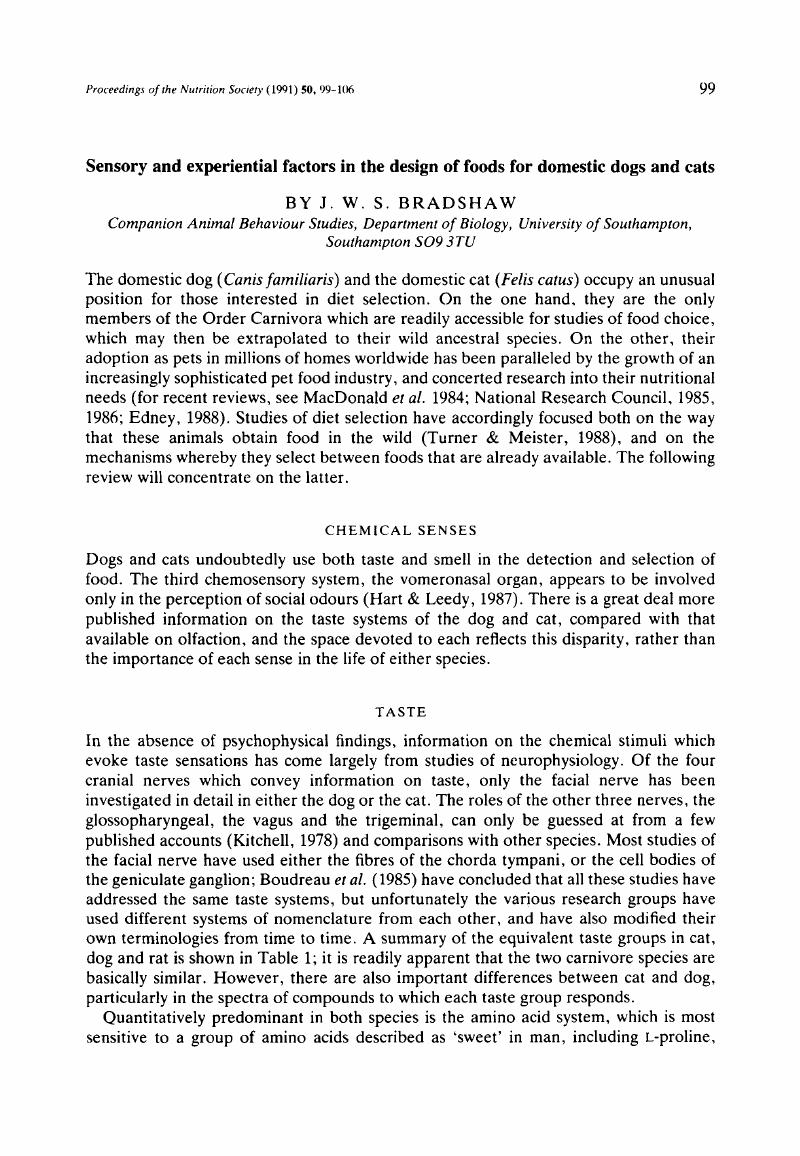Crossref Citations
This article has been cited by the following publications. This list is generated based on data provided by Crossref.
Church, Stuart C.
Allen, John A.
and
Bradshaw, John W. S.
1996.
Frequency‐dependent Food Selection by Domestic Cats: A Comparative Study.
Ethology,
Vol. 102,
Issue. 3,
p.
495.
Hullár, I.
Fekete, S.
Andrásofszky, E.
Szöcs, Z.
and
Berkényi, T.
2001.
Factors influencing the food preference of cats.
Journal of Animal Physiology and Animal Nutrition,
Vol. 85,
Issue. 7-8,
p.
205.
Thombre, Avinash G
2004.
Oral delivery of medications to companion animals: palatability considerations.
Advanced Drug Delivery Reviews,
Vol. 56,
Issue. 10,
p.
1399.
Li, Xia
Li, Weihua
Wang, Hong
Cao, Jie
Maehashi, Kenji
Huang, Liquan
Bachmanov, Alexander A
Reed, Danielle R
Legrand-Defretin, Véronique
Beauchamp, Gary K
Brand, Joseph G
and
Flint, Jonathan
2005.
Pseudogenization of a Sweet-Receptor Gene Accounts for Cats' Indifference toward Sugar.
PLoS Genetics,
Vol. 1,
Issue. 1,
p.
e3.
Zaghini, G.
and
Biagi, G.
2005.
Nutritional Peculiarities and Diet Palatability in the Cat.
Veterinary Research Communications,
Vol. 29,
Issue. S2,
p.
39.
Bradshaw, John W S
2006.
The Evolutionary Basis for the Feeding Behavior of Domestic Dogs (Canis familiaris) and Cats (Felis catus).
The Journal of Nutrition,
Vol. 136,
Issue. 7,
p.
1927S.
Pickering, G. J.
2009.
Optimizing the sensory characteristics and acceptance of canned cat food: use of a human taste panel.
Journal of Animal Physiology and Animal Nutrition,
Vol. 93,
Issue. 1,
p.
52.
Bohannon, John
Goldstein, Robin
and
Herschkowitsch, Alexis
2010.
Can People Distinguish Pâté from Dog Food?.
CHANCE,
Vol. 23,
Issue. 2,
p.
43.
Bohannon, John
Goldstein, Robin
and
Herschkowitsch, Alexis
2010.
Can People Distinguish Pâté from Dog Food?.
CHANCE,
Vol. 23,
Issue. 2,
p.
43.
Batchelor, D. J.
Al-Rammahi, M.
Moran, A. W.
Brand, J. G.
Li, X.
Haskins, M.
German, A. J.
and
Shirazi-Beechey, S. P.
2011.
Sodium/glucose cotransporter-1, sweet receptor, and disaccharidase expression in the intestine of the domestic dog and cat: two species of different dietary habit.
American Journal of Physiology-Regulatory, Integrative and Comparative Physiology,
Vol. 300,
Issue. 1,
p.
R67.
Di Donfrancesco, B.
Koppel, K.
and
Chambers, E.
2012.
An Initial Lexicon for Sensory Properties of Dry Dog Food.
Journal of Sensory Studies,
Vol. 27,
Issue. 6,
p.
498.
Koppel, Kadri
2014.
Sensory analysis of pet foods.
Journal of the Science of Food and Agriculture,
Vol. 94,
Issue. 11,
p.
2148.
Aldrich, Gregory
and
Koppel, Kadri
2015.
Pet Food Palatability Evaluation: A Review of Standard Assay Techniques and Interpretation of Results with a Primary Focus on Limitations.
Animals,
Vol. 5,
Issue. 1,
p.
43.
Hanson, Michaela
Jojola, Susan M.
Rawson, Nancy E.
Crowe, Melissa
and
Laska, Matthias
2016.
Facial expressions and other behavioral responses to pleasant and unpleasant tastes in cats (Felis silvestris catus).
Applied Animal Behaviour Science,
Vol. 181,
Issue. ,
p.
129.
Thompson, Hannah
Riemer, Stefanie
Ellis, Sarah L.H.
and
Burman, Oliver H.P.
2016.
Behaviour directed towards inaccessible food predicts consumption—A novel way of assessing food preference.
Applied Animal Behaviour Science,
Vol. 178,
Issue. ,
p.
111.
Song, Yunmei
Peressin, Karl
Wong, Pooi Yin
Page, Stephen W.
and
Garg, Sanjay
2016.
Key Considerations in Designing Oral Drug Delivery Systems for Dogs.
Journal of Pharmaceutical Sciences,
Vol. 105,
Issue. 5,
p.
1576.
Donfrancesco, Brizio Di
and
Koppel, Kadri
2017.
Sensory Characteristics and Volatile Components of Dry Dog Foods Manufactured with Sorghum Fractions.
Molecules,
Vol. 22,
Issue. 6,
p.
1012.
Belloir, Christine
Savistchenko, Jimmy
Neiers, Fabrice
Taylor, Andrew J.
McGrane, Scott
Briand, Loïc
and
Abe, Keiko
2017.
Biophysical and functional characterization of the N-terminal domain of the cat T1R1 umami taste receptor expressed in Escherichia coli.
PLOS ONE,
Vol. 12,
Issue. 10,
p.
e0187051.
Hall, Nathaniel J.
Péron, Franck
Cambou, Stéphanie
Callejon, Laurence
and
Wynne, Clive D.L.
2017.
Food and Food-Odor Preferences in Dogs: A Pilot Study.
Chemical Senses,
Vol. 42,
Issue. 4,
p.
361.
Di Donfrancesco, Brizio
Koppel, Kadri
and
Aldrich, Charles Gregory
2018.
Pet and owner acceptance of dry dog foods manufactured with sorghum and sorghum fractions.
Journal of Cereal Science,
Vol. 83,
Issue. ,
p.
42.



